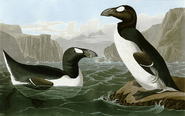
The Great Auk (Pinguinus impennis) is an extinct flightless sea bird native to Iceland, Greenland, and the coasts of Canada, the UK, Norway, Ireland, the Faroe Islands, and some parts of Spain. It became extinct in the 19th century when the last two living specimens were killed on Eldy off the coast of Ireland. Despite appearances, it was not related to penguins, despite being the first bird to be called a "penguin". It was the second largest bird in its family (30 to 33 inches tall), only Miomancalla was larger. Northern auks tended to be larger than southern auks. It was an important part of Native American culture, both as a food source and as a symbolic item. Many people were buried with its bones, one was even buried beneath 200 auk beaks. However, demand for its down in Europe caused the Great auk to be over hunted, even after protection laws went into effect. As it only had one hatchling per year, it was unable to breed fast enough to replenish its population. There is a monument to the last Great auk located on Orkney in the UK. The last sighting of the Great Auk was in 1852 on the Grand Banks of Newfoundland.
Taxonomy and evolution[]
Description[]

Taxidermy
Standing about 75 to 85 centimetres (30 to 33 in) tall and weighing approximately 5 kilograms (11 lb) as adult birds, the flightless great auk was the second-largest member of both its family and the order Charadriiformes overall, surpassed only by the mancalline Miomancalla. It is, however, the largest species to survive into modern times. The great auks that lived farther north averaged larger in size than the more southerly members of the species. Males and females were similar in plumage, although there is evidence for differences in size, particularly in the bill and femur length. The back was primarily a glossy black, and the belly was white. The neck and legs were short, and the head and wings small. The great auk appeared chubby due to a thick layer of fat necessary for warmth. During summer, it developed a wide white eye patch over each eye, which had a hazel or chestnut iris. During winter the great auk moulted and lost this eye patch, which was replaced with a wide white band and a gray line of feathers that stretched from the eye to the ear. During the summer, its chin and throat were blackish-brown and the inside of the mouth was yellow. In winter, the throat became white. Some individuals reportedly had grey plumage on their flanks, but the purpose, seasonal duration, and frequency of this variation is unknown. The bill was large at 11 centimetres (4.3 in) long and curved downward at the top; the bill also had deep white grooves in both the upper and lower mandibles, up to seven on the upper mandible and twelve on the lower mandible in summer, although there were fewer in winter. The wings were only 15 centimetres (5.9 in) in length and the longest wing feathers were only 10 centimetres (3.9 in) long. Its feet and short claws were black, while the webbed skin between the toes was brownish black. The legs were far back on the bird's body, which gave it powerful swimming and diving abilities.
Distribution and habitat[]
Ecology and behavior[]
Relationship with humans[]
In the Media[]
- The Great Auk was seen as a stuffed Museum Specimen in Batman The Animated Series Season 3 Catwalk on the Extinct Forever display with a few other stuffed Extinct animals. Then it along with the Tasmanian Tiger Wolf was stolen by Scarface to make money from them & almost sold it to Penguin.
- The Great Auk appeared in the documentary series Extinct or Alive.
Classification[]
| Scientific classification | |
|---|---|
| Kingdom: | Animalia |
| Phylum: | Chordata |
| Class: | Aves |
| Order: | Charadriiformes |
| Family: | Alcidae |
| Genus: | †Pinguinus Bonnaterre, 1791 |
| Species: | †P. impennis |
| Binomial name | |
| †Pinguinus impennis (Linnaeus, 1758) | |











